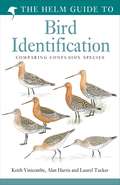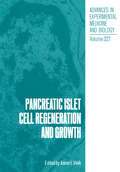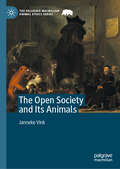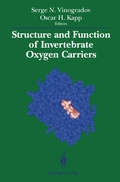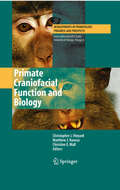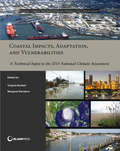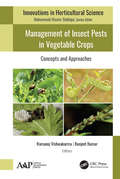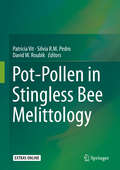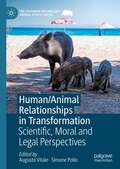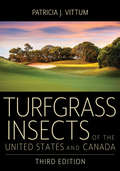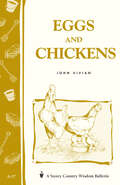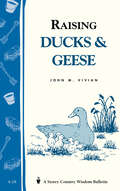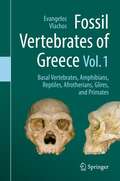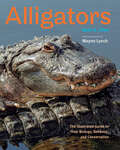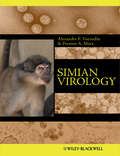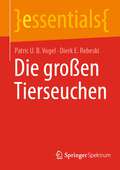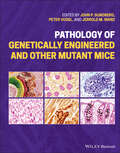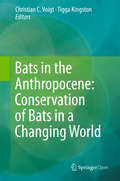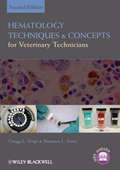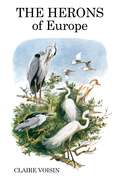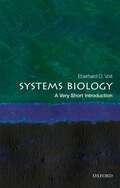- Table View
- List View
The Helm Guide to Bird Identification
by Keith Vinicombe Alan HarrisThis ebook covers difficult identification issues by looking at tricky species pairs or groups of birds, and comparing and contrasting their respective features. Designed as a field companion, it supplements the standard field guides and provides much additional information. As well as detailed texts, the books include extensive illustrations of all relevant ages and plumages of the species concerned.
Pancreatic Islet Cell Regeneration and Growth (Advances in Experimental Medicine and Biology #321)
by Aaron I. VinikAaron I. Vinik, M.D., Ph.D. I IEastem Virginia Medical School The Diabetes Institutes Norfolk, Virginia 23510 This symposium, held in June 1991, was a gathering of international scientists to exchange their views on current concepts of cell growth and differentiation. Each scientist was asked to present a topic of their research related to cell growth and regeneration and to participate in a round table conference elaborating on current knowledge and sharing their experiences. By furthering this promising area of endeavor, a means of understanding ontogeny of cell development and of providing insights into tumor biology would prevail. Of prime importance was the anticipation that new information from a better understanding of the normal evolution of the pancreatic islet would generate alternative approaches to curing diabetes. This forward serves as a short introduction to the concept of pancreatic islet regeneration and the models currently in use to study the process. DEVELOPMENTAL ORIGIN OF ISLETS DURING EMRYOGENESIS The developing pancreas appears as a protrusion from the dorsal surface of the l embryonic gut. The different islet cell types appear sequentially during development in vivo. It therefore seems reasonable to propose that coordinated growth is dependent upon specificity of growth factors.
The Open Society and Its Animals (The Palgrave Macmillan Animal Ethics Series)
by Janneke VinkThis book is an interdisciplinary study centred on the political and legal position of animals in liberal democracies. With due concern for both animals and the sustainability of liberal democracies, The Open Society and Its Animals seeks to redefine animals’ political-legal position in the most successful political model of our time. Advancements in modern science point out that many animals are sentient and that, like humans, they have certain elementary interests. The revised perception of animals as beings with elementary interests raises questions concerning the liberal democratic institutional framework: does a liberal democracy have a responsibility towards the animals on its territory, and if so, what kind? Do animals need legal animal rights and lawyers to represent them in court, and should they also be represented in parliament? And how much change of this kind could a liberal democracy really endure? Vink addresses these and other pressing questions relating to the political and legal position of animals in this persuasive and authoritative work, compelling us to reconsider the relationship between the open society and the animals in it.
Structure and Function of Invertebrate Oxygen Carriers
by Serge N. Vinogradov Oscar H. KappOxygen binding proteins are large multi unit proteins ideally suited for the study of structure function relationships in biological molecules. This book, based on a Symposium at the Xth International Biophysics Congress in 1990, provides a synthesis of recent advances in our knowledge of invertebrate oxygen carriers such as hemoglobins, hemocyanins, and hemorythrins. Comprehensive reviews are combined with new research results of importance to all biochemists and molecular biologists interested in oxygen carriers in general, their gene structure and comparative biochemistry. Of particular value are the studies of invertebrate oxygen binding proteins which perform their function and have structures vastly different from the vertebrate hemoglobins and myoglobins, as well as numerous examples of modern molecular techniques as applied to research on this diverse group of proteins.
Primate Craniofacial Function and Biology (Developments in Primatology: Progress and Prospects)
by Chris Vinyard Matthew J. Ravosa Christine WallPrimate Craniofacial Function and Biology is an integrative volume with broad coverage of current research on primate craniofacial biology and function. Topic headings include: the mammalian perspective on primate craniofacial form and function, allometric and comparative morphological studies of primate heads, in vivo research on primate mastication, modeling of the primate masticatory apparatus, primate dental form and function, and palaeoanthropologic studies of primate skulls. Additionally, the volume includes introductory chapters discussing how primatologists study adaptations in primates and a discussion of in vivo approaches for studying primate performance. At present, there are no texts with a similar focus on primate craniofacial biology and no sources that approach this topic from such a wide range of research perspectives. This breadth of research covered by leaders in their respective fields make this volume a unique and innovative contribution to biological anthropology.
The Elephant and the Bad Baby
by Elfrida Vipont Raymond BriggsThe Elephant and the Bad Baby is the classic story from Elfrida Vipont and Raymond Briggs.The Elephant takes the Bad Baby for a ride and they go 'rumpeta, rumpeta, rumpeta down the road.' They help themselves to ice creams, pies, buns, crisps, biscuits, lollipops and apples, and the shopkeepers follow them down the road shouting and waving. All ends well as the Bad Baby learns to say 'Please' and his mother makes pancakes for everyone.Elfrida Vipont worked as a teacher, singer and writer. She wrote over 30 books and won the Carnegie Medal in 1950 for Lark on the Wing. Raymond Briggs has produced wonderful children's books including the classic titles The Snowman, Father Christmas and When the Wind Blows - all made into immensely successful films. Raymond lives in Sussex.Look out for these other titles by Raymond Briggs:The Snowman; The Elephant and the Bad Baby; Father Christmas; Fungus the Bogeyman; Raymond Briggs's Christmas Little Library; The Father Christmas it's a Bloomin' Terrible Joke Book; Jim and the Beanstalk; Father Christmas Goes on Holiday
Coastal Impacts, Adaptation, and Vulnerabilities: A Technical Input to the 2013 National Climate Assessment (NCA Regional Input Reports)
by Virginia Burkett and Margaret DavidsonDeveloped to inform the 2013 National Climate Assessment, this report examines the known effects and relationships of climate change variables on the coasts of the US. It describes the impacts on natural and human systems, including several major sectors of the US economy, and covers the progress and challenges to planning and implementing adaptation options.
Management of Insect Pests in Vegetable Crops: Concepts and Approaches
by Ramanuj Vishwakarma Ranjeet KumarThis new book on the sustainable management of insect pests in important vegetables offers valuable management strategies in detail. It focuses on eco-friendly technology and approaches to mitigating the damage caused by insect pests with special reference to newer insecticides. Chapters in the volume provide an introduction to vegetable entomology and go on to present a plethora of research on sustainable eco-friendly pest management strategies for root vegetables, spice crops, tuber crops, and more.Vegetable crops that are infested by several insect pests from the nursery to the harvesting stage cause enormous crop losses. Given that it is estimated that up to 40 percent of global crops are lost to agricultural pests each year, new research on effective management strategies is vital. The valuable information provided in this book will be very helpful for faculty and advanced-level students, scientists and researchers, policymakers, and others involved in pest management for vegetable crops.
Pot-Pollen in Stingless Bee Melittology
by Patricia Vit Silvia R.M. Pedro David W. RoubikThis book covers pot-pollen—the other product, besides honey, stored in cerumen pots by Meliponini. Critical assessment is given of stingless bee and pot-pollen biodiversity in the Americas, Africa, Asia and Oceania. Topics addressed include historical biogeography, cultural knowledge, bee foraging behavior, pollination, ecological interactions, health applications, microbiology, the natural history of bee nests, and chemical, bioactive and individual plant components in stored pollen. Pot-pollen maintains the livelihoods of stingless bees and provides many interesting biological products that are just now beginning to be understood. The Meliponini have developed particular nesting biologies, uses of building materials, and an architecture for pollen storage. Environmental windows provide optimal temperature and availability of pollen sources for success in plant pollination and pollen storage. Palynological composition and pollen taxonomy are used to assess stingless honey bee pollination services. Pollen processing with microorganisms in the nest modifies chemical composition and bioactivity, and confers nutraceutical benefits to the honey and pollen widely relished by native people. Humans have always used stingless bees. Yet, sustainable meliponiculture (stingless bee-keeping) projects have so far lacked a treatise on pot-pollen, which experts provide in this transdisciplinary, groundbreaking volume.
Human/Animal Relationships in Transformation: Scientific, Moral and Legal Perspectives (The Palgrave Macmillan Animal Ethics Series)
by Augusto Vitale Simone PolloThe ethics of human/animal relationships is a growing field of academic research and a topic for public discussion and regulatory interventions from law-makers, governments and private institutions. Human/animal relationships are in transformation and understanding the nature of this process is crucial for all those who believe that the enlargement of moral and legal recognition to nonhuman animals is part of contemporary moral and political progress. Understanding the nature of this process means analysing and critically discussing the philosophical, scientific and legal concepts and arguments embedded in it. This book contributes to the discussion by bringing together the ideas and reflections of leading experts from different disciplinary backgrounds and with a range of scientific perspectives.This book both provides an up-to-date examination of the transformation of human/animal relationships and presents ideas to foster this process.
Turfgrass Insects of the United States and Canada
by Patricia J. VittumThe first edition of this reference work became known as the bible of turfgrass entomology upon publication in 1987. It has proved invaluable to professional entomologists, commercial turf managers, and golf course superintendents and has been used widely in college extension courses. This classic of the field is now in its third edition, providing up-to-date and complete coverage of turfgrass pests in the continental United States, Hawaii, and southern Canada.This revised volume integrates all relevant research from the previous two decades. It provides expanded coverage of several pest species, including the annual bluegrass weevil, invasive crane fly species, chinch bugs, billbugs, mole crickets, and white grubs. Patricia J. Vittum also provides detailed information on the biology and ecology of all major pests and includes the most current information on conditions that favor insect development and biological control strategies pertinent to each species.This edition will include more than 100 black-and-white images, including diagrams of life cycles, sketches of morphological characteristics, and charts highlighting seasonal activity. The book also includes 72 full-color plates (more than 500 color images), showing closeup pictures of most of the key insects (adult and immature stages) and damaged turf. The reader should be able to identify most turf insects through the use of this text. It is a critical reference work that any serious turf professional should own.
Eggs and Chickens: Storey's Country Wisdom Bulletin A-17 (Storey Country Wisdom Bulletin)
by John VivianSince 1973, Storey's Country Wisdom Bulletins have offered practical, hands-on instructions designed to help readers master dozens of country living skills quickly and easily. There are now more than 170 titles in this series, and their remarkable popularity reflects the common desire of country and city dwellers alike to cultivate personal independence in everyday life.
Raising Ducks & Geese: Storey's Country Wisdom Bulletin A-18 (Storey Country Wisdom Bulletin)
by John VivianSince 1973, Storey's Country Wisdom Bulletins have offered practical, hands-on instructions designed to help readers master dozens of country living skills quickly and easily. There are now more than 170 titles in this series, and their remarkable popularity reflects the common desire of country and city dwellers alike to cultivate personal independence in everyday life.
Fossil Vertebrates of Greece Vol. 1: Basal vertebrates, Amphibians, Reptiles, Afrotherians, Glires, and Primates
by Evangelos VlachosThis 2-volume set provides a state-of-the-art study of the fossil record and taxonomy of the main vertebrate groups from Greece. Greece stands between 3 continents and its vertebrate fossil record is of great importance for paleontological and evolutionary studies in Europe, Asia and Africa. Fossils from classic, world-famous localities (e.g., Pikermi, Samos) form an essential part of the collections of the most important museums in the world and have been studied by numerous scientists. Recent paleontological research led to the discovery and study of numerous new sites. The volumes contain a taxonomic review of all named and identified taxa, their taxonomic history and current status, as well as historical, phylogenetic and biogeographic information. Volume 1 contains a synopsis of the fossil record and taxonomy of important groups of vertebrates represented in the fossil record of Greece. The volume deals with some of the early splitting clades, including the basal and enigmatic conodonts and basal tetrapods like fishes, amphibians, and reptiles like lizards, snakes, crocodiles, turtles and tortoises. The second part of the volume deals with basal mammalian clades, some of which are quite characteristic for the fossil record of the country: aardwarks, hyraxes, proboscideans, elephants and mammoths, sea cows, rodents, and lagomorphs. The volume ends with special chapters on the primate fossil record of the country, including some of our most recent and distant relatives.
Alligators: The Illustrated Guide to Their Biology, Behavior, and Conservation
by Kent A. VlietFew scenes put the senses on edge more than a submerged alligator, only eyes and snout showing, when peering across a southern lake on a misty morning. An iconic American predator, these reptiles grow to thirteen feet or more and can live as long as humans. Alligators are complex creatures, capable of terrific attacks and yet tending to their young in the same gentle way a mother duck looks after her brood. Once extremely numerous, alligators came close to extinction in the twentieth century, but thanks to conservation efforts have since made a comeback, reclaiming their rightful place as the monarchs of the southern wetlands.In this fascinating account, richly illustrated with more than 150 photographs from award-winning wildlife photographer Wayne Lynch, expert zoologist Kent A. Vliet introduces readers to the biology, ecology, and natural history of the American alligator. Sharing nuanced depictions of their hidden lives that will forever change the way you think of these giant reptiles, the book• combines captivating storytelling with the most current scientific facts• chronicles the life cycle of the alligator• explains why the alligator's precise anatomy and physiology make it so successful• covers a wide range of topics, from courtship and reproduction to communication, basking, nest-building, and hunting• reveals the alligator's sophisticated social life in detail• evaluates the alligator's environmental role as a keystone species• examines the complicated relationship between alligators and people
Simian Virology
by Alexander F. Voevodin Preston A. MarxSimian Virology is the first text to comprehensively cover all currently known simian viruses. Chapters provide an overview of nonhuman primate models of medically important viral diseases as well as natural infections of nonhuman primates with human and animal viruses. The text covers a variety of topics including primate models of medically important viral diseases such as AIDS, hypotheses on the origins of epidemic forms of HIV, and viral diseases caused by non-simian viruses in both wild and captive primates.
Die großen Tierseuchen (essentials)
by Patric U. Vogel Dierk E. RebeskiSeit jeher wird die landwirtschaftliche Nutztierhaltung durch grassierende Tierseuchen und damit einhergehend die Nahrungsversorgung des Menschen mit Protein tierischen Ursprungs bedroht. Die Tierseuchenbekämpfung wird national und international per Verordnung und Gesetz geregelt, die u.a. umfangreiche Maßnahmen für die Errichtung von Sperrzonen, Keulung infizierter Tierbestände, Erstellung von Hygienevorschriften, Etablierung diagnostischer Methoden, Optimierung der Tierhaltung, präventive Verwendung von Impfstoffen, usw. gewährleisten. In diesem Buch werden beispielgebend einige der gefürchteten viralen Tierseuchen der Spezies Rind, Schaf, Ziege, Schwein, Pferd und Huhn beschrieben.
Pathology of Genetically Engineered and Other Mutant Mice
by Peter Vogel John P. Sundberg Jerrold M. WardPATHOLOGY OF GENETICALLY ENGINEERED AND OTHER MUTANT MICE An updated and comprehensive reference to pathology in every organ system in genetically modified mice The newly revised and thoroughly updated Second Edition of Pathology of Genetically Engineered and Other Mutant Mice delivers a comprehensive resource for pathologists and biomedical scientists tasked with identifying and understanding pathologic changes in genetically modified mice. The book is organized by body system, and includes descriptions and explanations of a wide range of findings, as well as hundreds of color photographs illustrating both common and rare lesions that may be found in genetically engineered and wild type mice. The book is written by experienced veterinary and medical pathologists working in veterinary medical colleges, medical colleges, and research institutes. Covering the latest discoveries in mouse pathology resulting from advancements in biotechnology research over the last 30 years, this singular and accessible resource is a must-read for veterinary and medical pathologists and researchers working with genetically engineered and other mice. Readers will also benefit from: A thorough introduction to mouse pathology and mouse genetic nomenclature, as well as databases useful for analysis of mutant mice An exploration of concepts related to validating animal models, including the Cinderella Effect Practical discussions of basic necropsy methods and grading lesions for computational analyses Concise diagnostic approaches to the respiratory tract, the oral cavity and GI tract, the cardiovascular system, the liver and pancreas, the skeletal system, and other tissuesl As a one-stop and up to date reference on mouse pathology, Pathology of Genetically Engineered and Other Mutant Mice is an essential book for veterinary and medical pathologists, as well as for scientists, researchers, and toxicologists whose work brings them into contact with genetically modified mice.
From the Seashore to the Seafloor: An Illustrated Tour of Sandy Beaches, Kelp Forests, Coral Reefs, and Life in the Ocean's Depths
by Janet VoightAn octopus expert and celebrated artist offer a deep dive to meet the enchanting inhabitants of the world’s marine ecosystems. Have you ever walked along the beach and wondered what kind of creatures can be found beneath the waves? Have you pictured what it would be like to see the ocean not from the shore but from its depths? These questions drive Janet Voight, an expert on mollusks who has explored the seas in the submersible Alvin that can dive some 14,000 feet below the water’s surface. In this book, she partners with artist Peggy Macnamara to invite readers to share her undersea journeys of discovery. With accessible scientific descriptions, Voight introduces the animals that inhabit rocky and sandy shores, explains the fragility of coral reefs, and honors the extraordinary creatures that must search for food in the ocean’s depths, where light and heat are rare. These fascinating insights are accompanied by Macnamara’s stunning watercolors, which illuminate these ecosystems and other scenes from Voight’s research. Together, they show connections between life at every depth—and warn of the threats these beguiling places and their eccentric denizens face.
Bats in the Anthropocene: Conservation of Bats in a Changing World
by Christian C. Voigt Tigga KingstonThis book focuses on central themes related to the conservation of bats. It details their response to land-use change and management practices, intensified urbanization and roost disturbance and loss. Increasing interactions between humans and bats as a result of hunting, disease relationships, occupation of human dwellings, and conflict over fruit crops are explored in depth. Finally, contributors highlight the roles that taxonomy, conservation networks and conservation psychology have to play in conserving this imperilled but vital taxon.With over 1300 species, bats are the second largest order of mammals, yet as the Anthropocene dawns, bat populations around the world are in decline. Greater understanding of the anthropogenic drivers of this decline and exploration of possible mitigation measures are urgently needed if we are to retain global bat diversity in the coming decades. This book brings together teams of international experts to provide a global review of current understanding and recommend directions for future research and mitigation.
Hematology Techniques and Concepts for Veterinary Technicians
by Gregg L. Voigt Shannon L. SwistNow in full color, Hematology Techniques and Concepts for Veterinary Technicians, Second Edition is a thorough update to this introduction to the fundamental concepts of collecting, handling, and preparing hematology samples. Covering the basics of blood composition, cell morphology, and sample collection, handling, and preparation, the book is designed specifically for veterinary technicians and students to gain a full understanding of why each test is performed and ensure accurate test results. In addition to addressing advances in technology, equipment, and test techniques throughout, a new chapter covers automated testing, and a companion website provides review questions and images from the book for download at www.wiley.com/go/voigt. Key concepts have also been added to each chapter to better promote learning, and terms are now defined throughout the text, with the definitions collected into a glossary. User-friendly and well-illustrated with charts, reference values, algorithms and photomicrographs, Hematology Techniques and Concepts for Veterinary Technicians, Second Edition is a key reference for veterinary technicians and veterinary technology students.
Hematology Techniques and Concepts for Veterinary Technicians
by Gregg L. Voigt Shannon L. SwistNow in full color, Hematology Techniques and Concepts for Veterinary Technicians, Second Edition is a thorough update to this introduction to the fundamental concepts of collecting, handling, and preparing hematology samples. Covering the basics of blood composition, cell morphology, and sample collection, handling, and preparation, the book is designed specifically for veterinary technicians and students to gain a full understanding of why each test is performed and ensure accurate test results. In addition to addressing advances in technology, equipment, and test techniques throughout, a new chapter covers automated testing, and a companion website provides review questions and images from the book for download at www.wiley.com/go/voigt. Key concepts have also been added to each chapter to better promote learning, and terms are now defined throughout the text, with the definitions collected into a glossary. User-friendly and well-illustrated with charts, reference values, algorithms and photomicrographs, Hematology Techniques and Concepts for Veterinary Technicians, Second Edition is a key reference for veterinary technicians and veterinary technology students.
The Herons of Europe (Poyser Monographs)
by Claire VoisinAlthough the majority of the world's Herons live in the tropics and subtropics, Europe is home to nine species, some large, some small, some colonial, some solitary breeders. Highly specialized birds, they exhibit many interesting differences in their behaviour and ecology and are a favourite group for many ornithologists. Voisin begins her book with a general description of the family before going on to treat each species in more detail. The species accounts summarize such topics as field characters, distribution, population size, breeding and feeding ecology and behaviour.
Systems Biology: Vignettes In Systems Biology (Very Short Introductions)
by Eberhard O. VoitSystems biology came about as growing numbers of engineers and scientists from other fields created algorithms which supported the analysis of biological data in incredible quantities. Whereas biologists of the past had been forced to study one item or aspect at a time, due to technical and biological limitations, it suddenly became possible to study biological phenomena within their natural contexts. This interdisciplinary field offers a holistic approach to interpreting these processes, and has been responsible for some of the most important developments in the science of human health and environmental sustainability. This Very Short Introduction outlines the exciting processes and possibilities in the new field of systems biology. Eberhard O. Voit describes how it enabled us to learn how intricately the expression of every gene is controlled, how signaling systems keep organisms running smoothly, and how complicated even the simplest cells are. He explores what this field is about, why it is needed, and how it will affect our understanding of life, particularly in the areas of personalized medicine, drug development, food and energy production, and sustainable stewardship of our environments. Throughout he considers how new tools are being provided from the fields of mathematics, computer science, engineering, physics, and chemistry to grasp the complexity of the countless interacting processes in cells which would overwhelm the cognitive and analytical capabilities of the human mind. ABOUT THE SERIES: The Very Short Introductions series from Oxford University Press contains hundreds of titles in almost every subject area. These pocket-sized books are the perfect way to get ahead in a new subject quickly. Our expert authors combine facts, analysis, perspective, new ideas, and enthusiasm to make interesting and challenging topics highly readable.
Systems Biology: A Very Short Introduction (Very Short Introductions)
by Eberhard O. VoitSystems biology came about as growing numbers of engineers and scientists from other fields created algorithms which supported the analysis of biological data in incredible quantities. Whereas biologists of the past had been forced to study one item or aspect at a time, due to technical and biological limitations, it suddenly became possible to study biological phenomena within their natural contexts. This interdisciplinary field offers a holistic approach to interpreting these processes, and has been responsible for some of the most important developments in the science of human health and environmental sustainability. This Very Short Introduction outlines the exciting processes and possibilities in the new field of systems biology. Eberhard O. Voit describes how it enabled us to learn how intricately the expression of every gene is controlled, how signaling systems keep organisms running smoothly, and how complicated even the simplest cells are. He explores what this field is about, why it is needed, and how it will affect our understanding of life, particularly in the areas of personalized medicine, drug development, food and energy production, and sustainable stewardship of our environments. Throughout he considers how new tools are being provided from the fields of mathematics, computer science, engineering, physics, and chemistry to grasp the complexity of the countless interacting processes in cells which would overwhelm the cognitive and analytical capabilities of the human mind. ABOUT THE SERIES: The Very Short Introductions series from Oxford University Press contains hundreds of titles in almost every subject area. These pocket-sized books are the perfect way to get ahead in a new subject quickly. Our expert authors combine facts, analysis, perspective, new ideas, and enthusiasm to make interesting and challenging topics highly readable.
